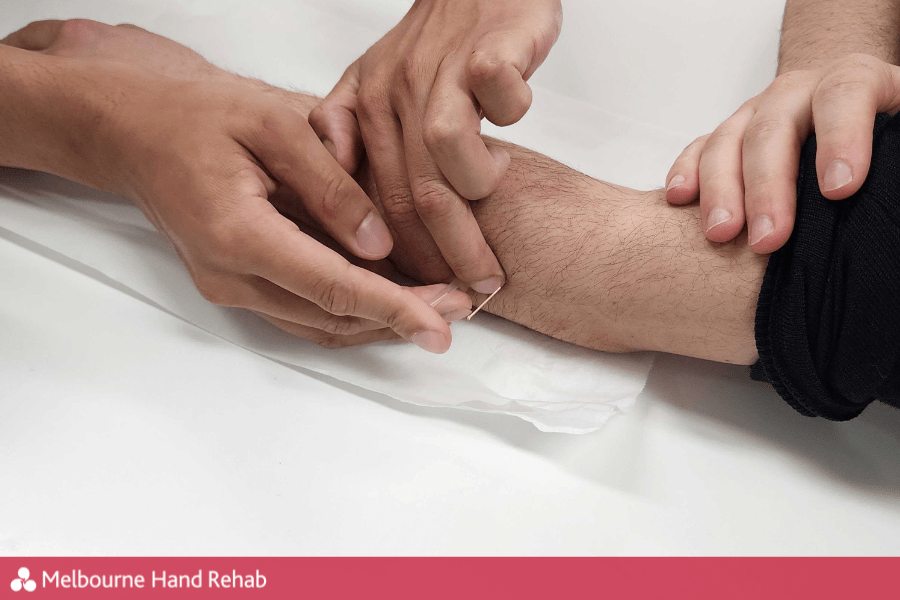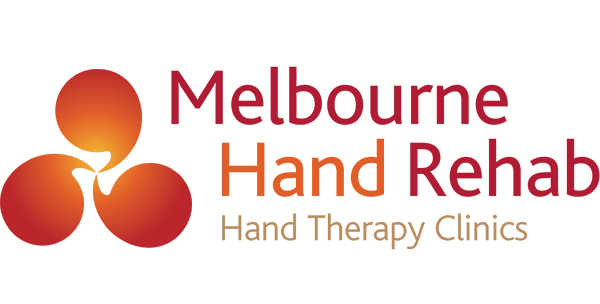
01 May Dry Needling in Hand Therapy
Dry needling is a powerful, evidence-based technique that’s gaining traction in hand rehabilitation—yet often overlooked in favor of traditional methods such as manual therapy, exercises, and splinting when treating hand injuries or chronic pain.
So, what is dry needling, and how can it benefit those struggling with hand pain or dysfunction? In fact, let’s dive into this modern therapeutic approach and explore why more hand therapists are adding it to their treatment toolkit.
What Is Dry Needling?
Dry needling is performed by trained healthcare professionals. It involves inserting thin, sterile needles into myofascial trigger points—tight bands within a muscle—to reduce pain, improve mobility, and restore function. Unlike acupuncture, which is rooted in traditional Chinese medicine, dry needling is based on Western anatomical and neurophysiological principles.

Intramuscular stimulation for a left forearm post ORIF (Open Reduction Internal Fixation) radial head and capitellum fracture.
Why is it used in Hand Therapy?
The hand is a complex network of small muscles, tendons, ligaments, and nerves. Even minor dysfunctions in this area can have a major impact on daily activities. Furthermore, dry needling can address several challenges that traditional techniques may struggle to reach on their own.
1. Pain Relief: Trigger points in the forearm and hand muscles can refer pain locally or to other parts of the arm and hand. As a result, dry needling helps deactivate these trigger points, often resulting in immediate pain reduction and improved comfort.
2. Increased Range of Motion: Muscle tightness and soft tissue restrictions can limit joint mobility. Consequently, by releasing tension at a deep muscular level, dry needling can improve flexibility and joint mobility, making it easier for patients to perform therapeutic exercises or resume everyday tasks.
3. Improved Muscle Activation: After injury or surgery, some hand muscles may not fire effectively due to pain or disuse. Dry needling may help “reset” muscle activity, enhancing motor control and supporting proper movement patterns during recovery.
4. Reduction of Inflammation and Swelling: Intramuscular stimulation stimulates a local healing response, which may help decrease inflammation and encourage tissue repair—as a result, it is especially useful in conditions like tendonitis or after overuse injuries.
Common Hand Conditions Treated with Dry Needling
- Carpal tunnel syndrome.
- Lateral and medial epicondylitis (tennis/golfer’s elbow).
- Trigger finger.
- De Quervain’s tenosynovitis.
- Hand and wrist pain from overuse.
- Post-operative stiffness and scar sensitivity.
Is It Safe?
When performed by certified practitioners, it’s generally safe and well-tolerated. Patients may feel a brief cramping sensation or soreness following treatment—similar to a post-workout feeling—but serious side effects are rare.
A Complement, not a Cure-All.
Dry needling isn’t a standalone treatment. It’s most effective when integrated into a comprehensive hand therapy program that includes manual therapy, therapeutic exercises, neuromuscular re-education, and patient education.
So, if you’re experiencing finger, hand, wrist, or shoulder pain, don’t hesitate to get in touch. We’d love to help you.
BOOK AN APPOINTMENT
For more information, call us directly on 03 9458 5166
You might also be interested in:
- Hand & wrist injuries in tennis players
- How Much Does a Splint Cost?
- Tennis Elbow: causes, symptoms & treatment
- Post-operative Hand Therapy
- De Quervain’s Tenosynovitis
- Video: Making a splint for De Quervain’s Tenosynovitis



